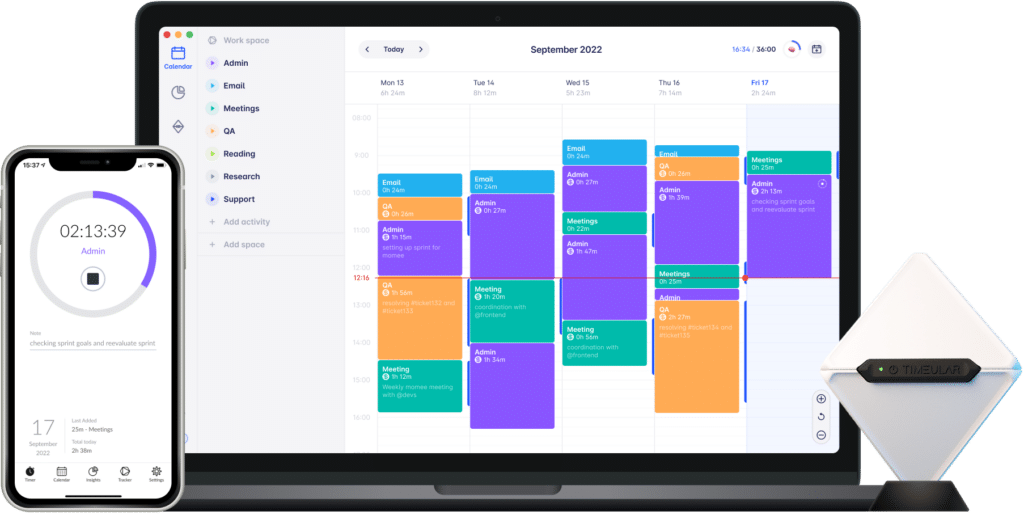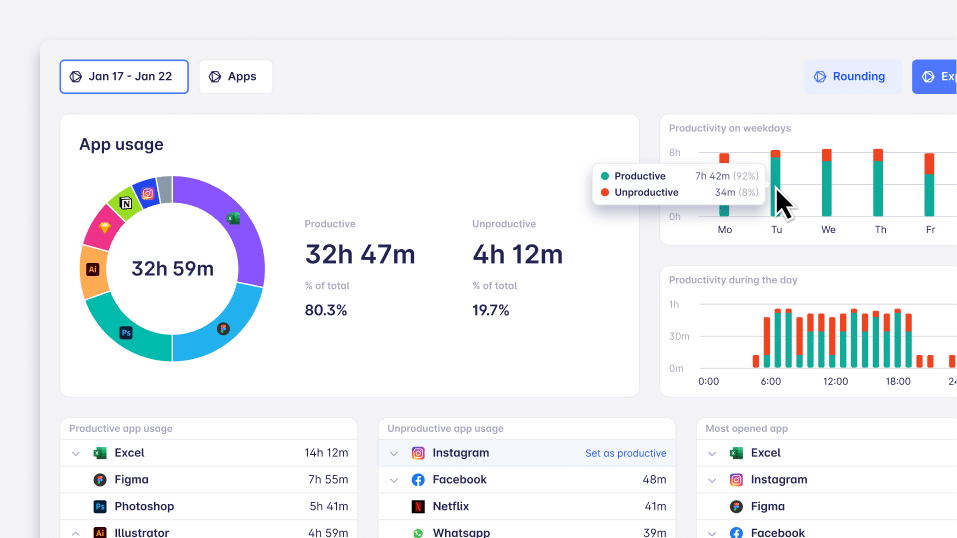Hur man mäter medarbetarnas produktivitet [GUIDE]
Medarbetarnas produktivitet avgör vad ditt företagoch ditt team kan åstadkomma. I slutändan är det det som avgör om ditt företag är framgångsrikt eller inte.
Om du har en ledarroll är ovanstående uttalande ingen nyhet eftersom du alltid letar efter en produktivitetsformel och medarbetarnas produktivitet överlag.
Och även om du kanske känner till hur man mäter medarbetarnas produktivitet och individuella mål , vet du hur man mäter medarbetarnas produktivitet på djupet?
Dyk ner i den här artikeln för att ta reda på hur.

Att följa upp tiden tillsammans med ditt team hjälper dig att förstå var din tid tar vägen
Vad är teamets produktivitet?
Produktivitet mäter och anger hur väl ett team eller en individ presterar.
Det är i grund och botten ett mått på effektiviteten - antingen hos en anställd, en maskin, ett system eller andra - när det gäller att omvandla input till output.
För att fastställa produktivitetsgraden kan man tänka sig ett förhållande mellan den output som genereras (t.ex. marknadsföringsmaterial, uppnådda mål etc.) och den input som investeras (tid, resurser etc.).
Men hur kan du mäta produktiviteten med större precision? Hur kan du verkligen veta om ditt team är produktivt och om du kommer att uppnå specifika mål?
I motsats till vad du kanske tror bör det inte krävas mycket mental gymnastik för att mäta medarbetarnas produktivitet, men låt oss utforska det härnäst!
Läs också: Sätt att förbättra medarbetarnas produktivitet

Hur man mäter medarbetarnas produktivitet på arbetsplatsen
Att korrekt mäta medarbetarnas produktivitet är ett viktigt steg i arbetsledningen, liksom att förstå den på rätt sätt.
Produktivitetsdata ger dig en korrekt bild av ditt företags produktivitet, prestanda och övergripande lönsamhet.
Beroende på hur ditt team arbetar finns det olika sätt att mäta produktiviteten.
Genom att mäta teamets produktivitet beräknar du hur mycket arbete ett team kan producera under en viss tid, t.ex. en månad eller ett år. Teamets produktivitet beror på många faktorer, t.ex. KPI:er eller produktivitetsnivåer för varje medarbetare samt deras färdigheter och kunskaper.
Kolla in det här:
Många andra faktorer, som teamkommunikation, arbetsmiljö, företagskultur och motivationsnivåer, påverkar också i hög grad deras individuella insatser och hur de mår.
Du hittar de bästa metoderna för att följa upp framsteg och beräkna produktivitet i många riktlinjer, men kom ihåg att varje företag och team är unikt. Det bästa vore om du valde de effektiva metoder som passar din arbetsplats bäst.
Med tanke på dessa skillnader är det uppenbart att produktivitetsmått också kommer att skilja sig åt.
Så om du är en chef som försöker mäta ditt teams produktivitet, ställ dig själv följande frågor:
- Vilken typ av prestation kan du kalla produktiv?
- Finns det en försäljnings- eller produktionskvot som ett team måste uppfylla?
- Vilka är de viktigaste målen för varje team?
Även om det finns många sätt att följa upp teamets produktivitet, ska vi nu se hur du kan göra det.

1. Tidsplanering i arbetet
Att hantera sin tid innebär att organisera, hantera och prioritera den. Omman tar det ett steg längre måste man kontrollera sin tid och energi för attdenna process skavara effektiv.
Anledningen till att ett gott förhållande till tid direkt påverkar produktiviteten kan härledas utan några krångligheter:
På så sätt kan du maximera din tid på specifika uppgifter eller projekt så att du kan åstadkomma mer på kortare tid eller helt enkelt uppnå vissa mål snabbare.
Oavsett storleken på ditt företag kan du övervaka dina anställdas produktivitet baserat på hur de hanterar sin tid. Vissa mindre uppgifter, som att kolla ett mejl, kanske inte anses vara tillräckligt viktiga för att spåras. Siffrorna visar dock det motsatta.
Enligt en studie från McKinsey Global Institute Analysis-studieägnas i genomsnitt 28% av arbetstiden åt e-post, vi kollar e-post i genomsnitt 11 gånger per timme och 84% har e-post öppen i bakgrunden medan de arbetar.
Om du summerar den tiden, kan du då föreställa dig hur många timmar som läggs på e-post under ett år och som aldrig spåras och därför aldrig redovisas?
Obs: Jag föreslår inte att du mäter produktiviteten genom att sätta specifika tidsgränser för e-post, utan snarare att du uppmuntrar medarbetarna att tänka på den tid de lägger på e-post som ett första steg.

Hur tidsregistrering underlättar tidshantering
För att förbättra dina färdigheter i tidshanteringkan du lägga till tidsuppföljning i din rutin eller för ditt team.
Om du och dina medarbetare har en känsla av att ni behöver förbättra produktiviteten men inte vet var ni ska börja, kan det första praktiska steget vara att registrera den tid som läggs på alla arbetsuppgifter.

"Jag har fördubblat mina intäkter tack vare Timeular och lyckats halvera min arbetstid." Valdemar Alfred, ägare av Valdefar
En app för tidsregistrering fungerar som en kalkylator för medarbetarnas produktivitet utan manuell inblandning. Den kommer att informera dina beslut med data om följande:
- arbetsprestation, liksom arbetsprestation;
- arbetskostnader;
- företagets lönsamhet (inklusive projektlönsamhet);
- produktiva timmar som anställda arbetar på;
- om du bör tilldela uppgifter på ett annat sätt;
- administrativt arbete som tar för mycket tid och behöver automatiseras.
För att bättre förstå hur tidrapportering hjälper dig att mäta produktivitetsprocessen, följer här några funktioner i Timeular, ett tidrapporteringsverktyg:
- Det möjliggör automatisk tidsspårning: registrerar användning av appar, webbplatser och dokument, vilket ger 100% kontroll och efterlevnad av GDPR(notera: dina data lagras endast lokalt).
- Med AI får du automatiska förslag och påminnelser som fyller din kalender med ett klick baserat på dina kalenderhändelser.
- Som ett tidsrapporteringssystem genererar det enkelt rapporter med produktivitetstrender för appanvändning, och på så sätt kan du identifiera mönster. Då förstår du hur du kan öka produktiviteten innan du implementerar andra automatiserade processer.
- Spårning av fakturerbara och icke-fakturerbara timmar gör att du kan spåra icke-fakturerbara och fakturerbara timmar med ett klick.
- Lämna spårning och spårning av arbetstidinklusive betald ledighet och sjukfrånvaro, kan göras med ett klick och automatisk övertidsberäkning.

A verktyg för produktivitetsuppföljning kan till och med vara nödvändigt om du arbetar på distans eller har ett hybridupplägg.
Dina produktivitetsmätningar kommer att öka dina anställdas produktivitet och ge viktig information för att hålla dina projekt smidigt igång. Dessutom kan det säkerställa ett större ansvarstagande bland medarbetarna.
För att korrekt kunna fastställa medarbetarnas produktivitet måste du veta hur mycket tid som gick åt för att producera den totala produktionen, och du måste veta det så exakt som möjligt.
Nyfikenhet: Visste du att Timeular är en av de bästa produktivitetsapparna?
2. Kvalitet kontra kvantitet
Steve Jobs har redan sagt det, så det är inte jag:
"Kvalitet är viktigare än kvantitet. En homerun är mycket bättre än två dubblar."
Utan att gå in på de akademiska definitionerna, låt oss först helt enkelt fastställa vad kvalitet och kvantitet innebär:
kvalitet är "hur bra eller dåligt något är", vilket innebär att kvalitet är ett mått på förträfflighet
kvantiteten representerar "mängden eller antalet av något, särskilt det som kan mätas", vilket innebär att kvantiteten är omfattningen, storleken eller summan av något - ett numeriskt värde.
Men hur passar allt detta in i arbetet
Det är ganska vanligt att ledningen mäter medarbetarnas produktivitet baserat på kvantitet. Men det här sättet att mäta produktivitet är begränsande, både för den anställdes prestation och för företagets prestation i stort.
Om du har mätt produktiviteten på det vanliga sättet finns det några metoder som du kan börja använda (jag går in på mer detaljer längre fram):
resultatmått, kvalitetskontroller, kundnöjdhet och feedback, kollegial granskning, felfrekvenser, effektiviteten i arbetsprocessen och produktionen, innovation ochoch förbättringsförmåga.
Vill du förstå skillnaderna skillnaderna mellan produktivitet och effektivitet för mer klarhet?

3. Tydliga KPI:er och mål
För att avgöra om ditt team är produktivt kan du jämföra hur dina medarbetare klarade sina arbetsmål individuellt och som ett team.
Kontrollera ditt teams produktivitet genom att titta på deras mål och de mål de inte lyckades uppnå. Detta är en av anledningarna varför det är viktigt att sätta upp mål för ditt teamDet gör att du kan jämföra förväntade och faktiska prestationer.
Om ditt team misslyckas med att nå sina mål konsekvent bör en effektiv och direkt åtgärd vara gammaldags, väl utförd och tydlig kommunikation.
Kom ihåg att det inte är ett tecken på ökad produktivitet att få dina anställda att lägga ner fler arbetstimmar; det är snarare kontraproduktivt. Den tid som någon tillbringar på jobbet är inte samma sak som antalet timmar de arbetar.
Så, hur går ni vidare härifrån och vad kommunicerar ni?
Upprepa deras mål och KPIS. Medarbetare som är mer insatta i sina mål har visat sig vara mer produktiva än medarbetare som är mindre insatta i ämnet.
En medarbetare känner en djupare samhörighet med sitt företag och får en större känsla av syfte och tillhörighet när de vet vad som förväntas av dem.
Att öka teamets produktivitet kan vara så enkelt som att påminna dem om organisationens mål och dela upp arbetet med att uppnå dessa mål i mindre uppgifter.
- Kolla in: Bästa podcasts för produktivitet
4. Uppföljning av resultat
Att hålla koll på dina medarbetares prestationer är ett objektivt och praktiskt instrument för att mäta medarbetarnas produktivitet.
Att mäta produktiviteten i det här fallet kan alltså bedömas genom att kontrollera (beroende på roll):
försäljningsmål, betyg på kundservice, milstolpar i projekt, åtgärdade buggar, kodkvalitet, marknadsföringsstrategins effektivitet och mycket annat.
Tänk på att många externa faktorer ibland kan leda till dåliga resultat, så ha ett holistiskt synsätt när du gör din bedömning.
Prestationsuppföljning omfattar dock andra indikatorer än mål och är mycket lättare att mäta. Det handlar till exempel om huruvida dina medarbetare har en bra relation till sina kollegor och bidrar till organisationens kultur.

5. Förhållandet mellan planerat och utfört
Förhållandet mellan planerat och utfört mäter andelen uppgifter som slutfördes i förhållande till de uppgifter som tilldelades.
Genom att analysera dina medarbetares prestationer utifrån en given lista med uppgifter får du en djup inblick i teamets kapacitet och produktivitetspotential.
Produktivitetsprogram som t.ex. Timeularär ett praktiskt verktyg för att få fram denna information.
Låt oss anta att ditt team har mycket arbete i pipeline. De måste slutföra tio uppgifter varje månad för att klara tidsfristerna och de uppsatta målen. Men om de bara kan utföra fem uppgifter per månad blir förhållandet mellan planerat och utfört 50 %.
Om du har ett lågt förhållande mellan planerat och utfört kan det därför vara dags att anställa fler medarbetare för att slutföra arbetsuppgifterna, minska den nuvarande arbetsmängden eller omarbeta planeringsprocessen för att göra den mer effektiv.
TIPS: Använd en av de bästa apparna för tidsregistrering av anställda för att mäta medarbetarnas produktivitet och öka företagets effektivitet.
Fördelarna med att mäta ditt teams produktivitet
A studie från SHRM visar att 95% av cheferna är missnöjda med hur deras företag genomför utvecklingssamtal.
Denna frustration har lett till att vissa företag helt och hållet har övergett de årliga utvecklingssamtalen. Cheferna måste dock förstå hur viktigt det är och hur det kan gynna både den anställde och företaget.
Här är en lista över de fyra viktigaste fördelarna med att mäta produktivitet och prestanda.

1. Möjliggör tillväxt och utveckling för medarbetarna
Chefer som inte noggrant och noggrant mäter sina medarbetares prestationer kommer inte att ha någon kontakt med sina teams framgångar och misslyckanden.
Det gör det i princip omöjligt att ge konstruktiv feedback och få resultat. Utan värdefull feedback kommer medarbetarna att ha sämre möjligheter att förbättra sig, växa och utvecklas, och det kommer att få dem att gå vidare.
Att vara en bra ledare, öka medarbetarnöjdheten och göra det möjligt för människor att växa inom sina roller kontinuerligt.
Enligt en studie från HBR.org om att ge och ta emot feedback instämde 92% av de tillfrågade i påståendet att "negativ (omdirigerande) feedback, om den ges på rätt sätt, är effektiv för att förbättra prestationen".
Sanningen är att människor vill veta hur de presterar för att veta hur de kan utvecklas. Genom att noggrant mäta medarbetarnas prestationer kan du därför ge korrekt, målinriktad och specifik feedback om det görs på rätt sätt.

2. Skapa målanpassning
Att arbeta utan något specifikt mål i sikte är tråkigt. Alla som arbetar utan något särskilt syfte slutar med att känna sig frustrerade och omotiverade.
Medarbetare presterar bättre när de har mål att sträva efter och arbeta mot. Genom att mäta medarbetarnas prestationer kan cheferna justera och reglera dessa mål eftersom de får insikt i om någon presterar bra eller dåligt.
Målsättningen måste dock vara ett samtal om vad företaget behöver och hur medarbetaren kan bidra, och inte något som enbart sätts av cheferna utan medarbetarnas synpunkter.
När mål sätts utan medarbetarnas synpunkter eller prestationsdata kan de vara alltför ambitiösa och hindra företaget från att växa. Dessutom kan det bränna ut människor och få dem att känna sig omotiverade. Å andra sidan, när medarbetarna har mål som är för enkla, måste företaget utnyttja deras fulla potential.
Så om du leder ett team eller vill bygga upp ett bygga upp ett högpresterande teambör du regelbundet mäta medarbetarnas prestationer och diskutera med dem om deras projekt, mål och ambitioner.
På så sätt är det mindre sannolikt att de konfronteras med utbrända eller oengagerade team och mer sannolikt att de har medarbetare som uppfyller målen.
3. Kostnadsminskningar
När du noggrant registrerar din tid och mäter ditt teams produktivitet får du en bättre uppfattning om var du bör investera.
Vad är det som gör att ditt företag förlorar pengar?
När du beräknar arbetsproduktiviteten med hjälp av produktionsförhållandet och de pengar du investerat i produktionsprocessen kan du identifiera saker som kräver en mer betydande eller mindre investering.
När du har analyserat all information kan du bli förvånad över hur mycket pengar du kan spara genom att följa upp och jämföra produktivitetsmått över tid eller genom att investera smart på annat håll. Detta är ett av de smartaste sätten att förbättra affärseffektiviteten

4. Skapa en rättvis kultur av erkännande
Tyvärr är det många företag som inte ägnar så mycket uppmärksamhet åt detta. Om du mäter ditt teams prestationer korrekt, kompenserar du också medarbetarna korrekt med befordringar, interna rollförändringar eller andra saker.
Genom att analysera varje medarbetares prestationer kan du säkerställa att du kompenserar toppresterande på ett rättvist sätt genom att ge dem det erkännande de förtjänar och stödja lågpresterande medarbetare. Att förbättra den individuella prestationen hjälper medarbetarna att bidra till företagets framgång, men det hjälper också till att skapa balans mellan arbete och privatliv. Tänk på att arbete i allmänhet också kan påverka den psykiska och fysiska hälsan.
När medarbetarna tror att lågpresterande medarbetare tolereras utan konsekvenser kan det leda till frustration och en obehaglig miljö.
Läs vår blogg och ta reda på de bästa sätten att hålla ditt team motiverat att bli mer produktivt

"Jag har fördubblat mina intäkter tack vare Timeular och lyckats halvera min arbetstid." Valdemar Alfred, ägare av Valdefar
Slutsats
Förhoppningsvis har den här artikeln hjälpt dig att genomföra en grundlig process för produktivitetsmätning och bidragit till att förbättra ditt företags produktivitet.
Tänk på att olika team arbetar på olika sätt inom ett företag, så det är omöjligt att utvärdera deras totala produktivitet utifrån samma kriterier. Vad som gör ett marknadsföringsteam framgångsrikt skiljer sig till exempel från vad du förväntar dig av ett programvaruutvecklingsteam.
Dessutom kan vissa standarder skilja sig åt om ditt team arbetar på kontoret på heltid eller på distans.
Att förstå hur väl dina medarbetare presterar är dock avgörande för att kunna utvärdera din affärsutveckling och förbättra resultaten.